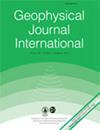An integrated method for gravity gradient inversion and gravity gradient depth imaging
IF 2.8
3区 地球科学
Q2 GEOCHEMISTRY & GEOPHYSICS
引用次数: 0
Abstract
Summary Gravity gradient data can show the structural features of geological bodies in the shallow lithosphere with higher sensitivity and resolution than conventional gravity data. Gravity gradient inversion can be applied to obtain the lithospheric density structures of geological bodies. However, as with gravity data, gravity gradient data have no inherent depth resolution. The methods of gravity gradient depth imaging and gravity gradient inversion are integrated in this study. The depth imaging method is effective for calculations without prior information and iterative computations. As the parameters in the depth weighting function should be chosen from a set of values used in inversion tests of synthetic data, which brings some uncertainties, the depth imaging results of gravity gradient are introduced into the depth weighting function. Several synthetic models are tested to demonstrate the advantages and features of the effective integrated method. Finally, the integrated method is applied to the interpretation of the GOCE satellite gravity gradient tensors over the northeastern margin of the Qinghai-Tibet Plateau. The results reveal that in the crust of the study area, the distribution of density anomalies is more in line with the mechanism of the crustal flow model, in the upper mantle of the study area, the density anomalies are mainly influenced by the high heat flow environment.重力梯度反演和重力梯度深度成像综合方法
摘要 重力梯度数据可以显示浅岩石圈地质体的结构特征,其灵敏度和分辨率均高于常规重力数据。重力梯度反演可用于获取地质体的岩石圈密度结构。然而,与重力数据一样,重力梯度数据没有固有的深度分辨率。本研究整合了重力梯度深度成像和重力梯度反演方法。深度成像法对于没有先验信息的计算和迭代计算非常有效。由于深度加权函数中的参数应从合成数据反演测试中使用的一组值中选择,这会带来一些不确定性,因此深度加权函数中引入了重力梯度的深度成像结果。对几个合成模型进行了测试,以展示有效集成方法的优势和特点。最后,将该综合方法应用于青藏高原东北缘 GOCE 卫星重力梯度张量的解释。结果表明,在研究区的地壳中,密度异常的分布更符合地壳流动模型的机理;在研究区的上地幔中,密度异常主要受高热流环境的影响。
本文章由计算机程序翻译,如有差异,请以英文原文为准。
求助全文
约1分钟内获得全文
求助全文
来源期刊

Geophysical Journal International
地学-地球化学与地球物理
CiteScore
5.40
自引率
10.70%
发文量
436
审稿时长
3.3 months
期刊介绍:
Geophysical Journal International publishes top quality research papers, express letters, invited review papers and book reviews on all aspects of theoretical, computational, applied and observational geophysics.
文献相关原料
| 公司名称 | 产品信息 | 采购帮参考价格 |
|---|
 求助内容:
求助内容: 应助结果提醒方式:
应助结果提醒方式:


